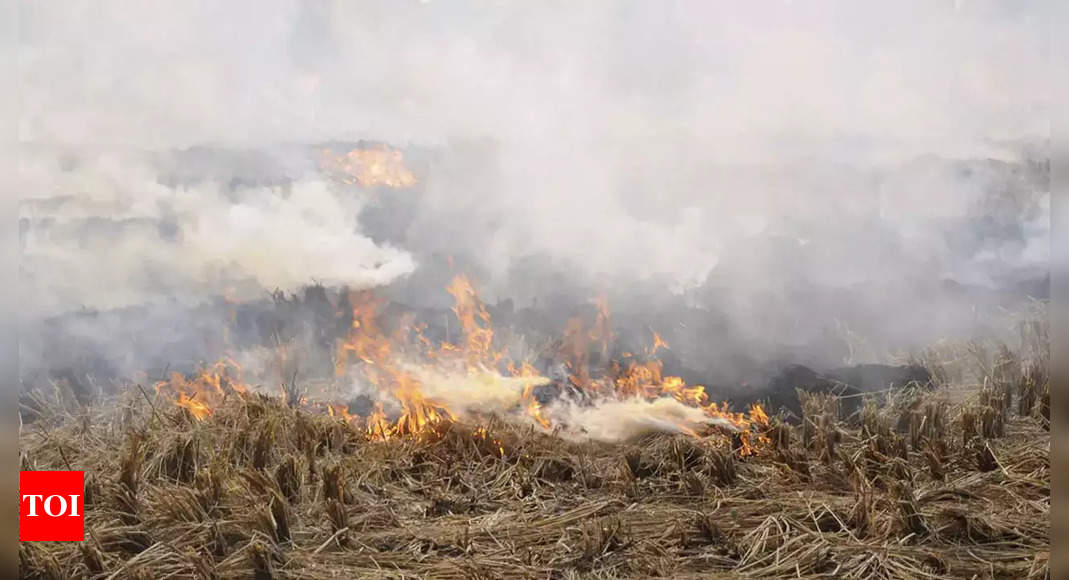LUDHIANA/PATIALA: Gurmail Singh emerges exhausted from his green paddy field in Jasso Majra, around 60km from Patiala. He unmounts the motorised weedicide spray kit off his shoulder, gives his back a good stretch and washes off the sweat in the stream gushing from a tubewell. His work is just half done. He needs to inspect the field regularly and manually remove weeds for many more days. It will take around 90 more days for the crop to turn from dark green to golden brown. TimesviewWinter is just three months away and the spectre of toxic fumes enveloping the city in a grey haze remains. It is a matter of concern that authorities in Punjab are yet to approach farmers who burn stubble, the root of the malady. One understands that the problem is complicated and solving it will require a combination of persuasion, subsidy and a firm hand. But it’s about time that the process is initiated. Let there be a sincere attempt to reduce stubble burning everywhere. And that includes Haryana tooOnce the paddy ripens, there will be the harvesting and then the question of what to do with the stubble left after reaping the rice. A subnormal harvest will mean farmers like 45-year-old Gurmail — who has already had a poor wheat harvest this year — will have other things on their mind than dealing with the stubble, the burning of which has become a contentious issue related to pollution in Delhi. “Managing the stubble on our own will starve us because it takes Rs 3,000-4000 per acre for us to either use balers or mix the crop remnants with the soil using seeders. Without financial help, it will be a suicide mission for us,” Gurmail said, as other farmers nodded in agreement. At its peak, the share of farm fire pollutants in Delhi’s air varies from 4% to 48%. With Punjab, one of largest rice producing states of India, now governed by the Aam Aadmi Party, like in Delhi, there is speculation about a change in policies. Track the pollution level in your cityDelhi government has always considered harvest fires in Punjab and Haryana responsible for Delhi’s pollution woes. The two AAP governments recently proposed to provide farmers an incentive of Rs 2,500 per acre to avoid burning. The two governments each expressed willingness to pay Rs 500 of the incentive and asked the central government to pay the remaining Rs 1,500. The status of the proposal is, as yet, unclear. With nothing concrete planned, Gurmail said, “Right now, we have no idea about what to do with the stubble, but we have been told that the government is up to something.” Gurmail felt that a government assistance of Rs 2,500 per acre could help the farmers dispose of the stubble without burning it. Daljeet Singh, 50, of Srinagar Puniwal, disagreed and declared, “Even Rs 2,500 won’t be adequate.” Daljeet explained that using seeders and balers had operations costs and required the use of larger tractors of more than 55 horsepower. Most tractors owned by farmers are rated at 35-45HP. Rampal Singh, 60, of Jalspal Bangar in Ludhiana, summed up the farmers’ thoughts. “We need assistance of Rs 3,000-4,000 per acre not to burn the stubble. A cooperative in our village can rent us the machines, but with so many farmers and such a small window to switch between the rice and wheat crops, we aren’t sure if the number of rented machines will be enough. The situation is the same in all parts of Punjab.” The aim is to have an additional 30,000 machines available before this harvest season, but government officials admitted to worrying about not being able to muster them. Cooperatives and farmer-run custom hiring centres offer machinery and related services in most Punjab villages. Their cost of operation varies from Rs 1,700 per acre in some places to upwards of Rs 2,500 in others depending on availability of machines, time and number of workers deployed. With farmers in Punjab planting two varieties of paddy — the early yielding PR121, PUSA Basmati 1509, PUSA 44, etc, which take around 90 days from sowing to harvest, and the late yielding PR121, PUSA Basmati 1121, etc, that take over 120 days — the harvest season and the subsequent timeline for stubble burning stretches from late September to late November. Jagdish Singh, joint director of agriculture engineering in Punjab government’s department of agriculture and farmers’ welfare, said, “This is the right time to start preparing for stubble management. From early September, we will also start educating farmers and encouraging them not to burn stubble. We have developed a mobile app called iKhet to inform farmers about the availability of stubble management machinery on rental. The challenge is to do this within the given timeframe.” The way Punjab government approaches its farmers in the next two months will decide if Delhi will again suffer the choking pollution from farm fires this winter. While the experts and government groups have, to an extent, succeeded in making farmers understand that stubble burning is harmful both for their fields and for the air over Delhi, the stumbling block is the monetary aspect of anti-burning measures. Recently, the Commission for Air Quality Management said straw generated by the rice crop should be efficiently managed by December 31, 2026. However, a plan to achieve this is yet to be formulated and success will rely largely on the capabilities of the state governments of Punjab, Haryana and Uttar Pradesh. “We aren’t clear whether farmers will be incentivised or not,” said one Punjab official. “For now, the best step would be to make stubble machines available in sufficient numbers. Rental subsidies, if possible, will be a bonus.” There are over 31 lakh hectares under paddy cultivation in Punjab, which, in 2021, produced an estimated 200 lakh tonnes of stubble. Managing this volume of stubble is beyond the means of the farmers. As Gurmail pointed out, “Music videos depict all Punjab farmers as rich, but it’s a misconception. There are costs involved with fertilisers, weedicides, irrigation, harvesting. There are also losses to cope with and bank loans to repay.” Onkar Singh, 70, a farmer leader from Agaul village, interjected with, “Punjab government says it will give us incentives, but it has put the onus on the central government. There are also allegations of funds allocated to buy stubble management machines being misused. Amid all this, the farmers are trapped in politics and stubble management is affected.”
Source: https://timesofindia.indiatimes.com/city/delhi/will-delhi-ncr-choke-on-punjab-farm-fires-funds-up-in-the-air-so-stubble-smoke-may-rise-too/articleshow/93463760.cms

